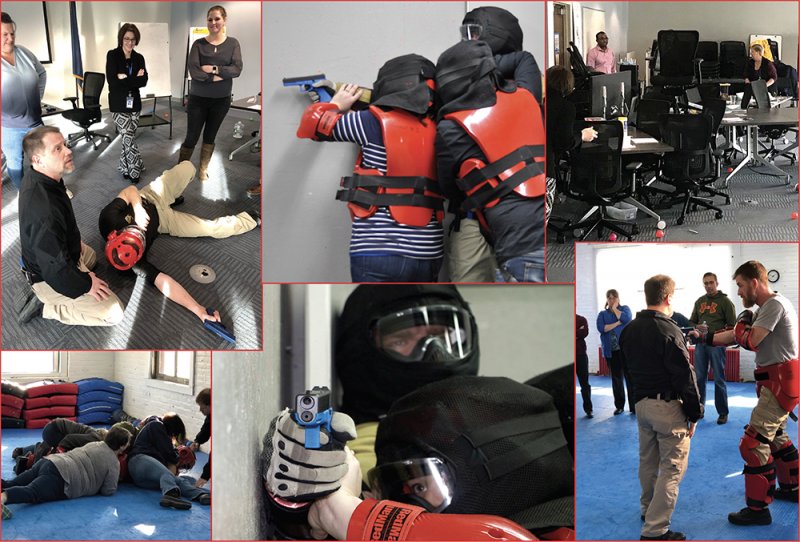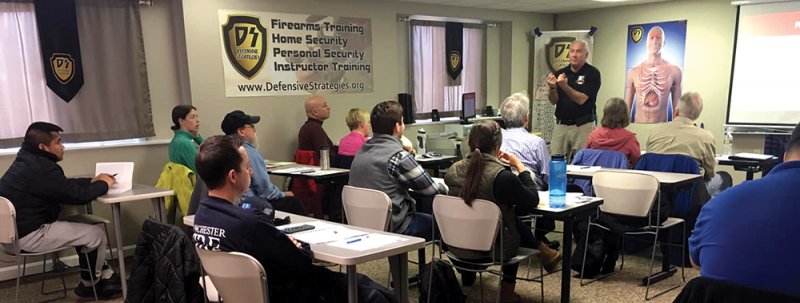
Active shooter training at Critical Defense in Manchester. Courtesy photos.
Most companies have a plan ... but not one for an active shooter.
Each year in this country around 800 people die in workplace attacks, with about half of those violent incidents involving guns. According to the National Institute for Occupational Safety and Health, workplace violence falls into four categories: criminal intent, customer/client, worker-on-worker, and personal relationship.
Regardless of what triggers an active shooter situation, experts say surviving or mitigating an attack comes down to planning, communication, awareness and recognition of the risks. But in a state with low crime rates, people can become complacent about workplace violence.
Rob Tibbo, owner and certified instructor at Critical Defense Institute, a firearms and self-defense training center in Manchester, says there is a disconnect between workplace attacks happening around the country and the very real risk faced by any organization, including those in NH. He says when his firm conducted a training session for a Seacoast employer, only half of the 250 employees showed up. Tibbo says when those who did attend realized how important it is that the entire company be on the same page, they became angry that others were not there.
Develop a Plan
Tibbo says when Critical Defense Institute works with corporate clients, they begin by surveying the property or facility to develop an emergency operation plan (EOP). “Most companies have an EOP for things like fire, or they have a safety team that can handle a cardiac arrest,” Tibbo says. “But they don’t generally have one for an active shooter scenario. These are two very different things. [Companies] think they can watch the Homeland Security video and then tell people to use the fire evacuation route. That’s just not true. There’s a lot of complacency by people who just don’t think it could ever happen, and they don’t take it seriously.”
Tibbo says the plan should spell out what needs to happen to make the facility safer, what management needs to do to ensure the safety of employees, and what responsibilities employees have to contribute to a safe atmosphere, to report concerns and to understand their role in any defensive actions.
This plan must align with what the first responders are going to do. “Thirty years of research have given us enough data to know that by the time police show up, the active shooting is done,” Tibbo says. “Therefore, anything that is going to be done to mitigate that shooting has got to be done ahead of time.”
Heed Warnings, Be Alert
While workplace attacks can be random, quite often they involve former employees. It is important to understand and look for preincident indicators, which include:
• Excessive absenteeism or lateness.
• Pushing limits of acceptable behavior.
• Disregard for safety policies.
• Disrespect for authority.
• Blaming others for mistakes.
• Complaints of unfair treatment.
• Poor personal hygiene.
• Holding grudges, especially against a supervisor.
Tibbo says the time for employees to share their concerns is before an incident. And that is also the time for HR to have a conversation to try to mitigate a potential problem. “Whether it is an employee having issues at home or problems with a co-worker, HR needs to be thinking about the possibility of violence. What if this guy loses it? Managers need to be aware of these signs, report altercations and follow up,” he says.
Robert Boilard, a master trainer, instructor and owner of Defensive Strategies , a firm in Manchester that teaches personal protection and safety strategies, says crimes typically have four steps: selection of the company or individual, stalking the intended victim, firming up decisions and planning, and then committing the actual crime. “You want to find a way to stop that crime in the first three steps. That comes back to awareness,” he says. “We start [clients] off with situational awareness and focus on prevention—employees keeping track of who is in the building, who doesn’t have a badge. A lot can be prevented just by paying attention. We’re a society buried in our cellphones and tablets and oblivious; just that situational awareness—getting people to think about how they will act—makes all the difference.”

Robert Boilard, owner of Defensive Strategies, leads a course in personal protection and safety strategies. Courtesy photo.
Responding to an Attack
When an attack occurs, chaos can ensue, and clear thinking and fast reactions can make all the difference. It is important to provide employees several options they can use to survive an active shooter incident, Tibbo says. “Evacuating is always the first thing you want to look at if you have a safe means, then do so. But you have to know when it is safe and when you should go into lockdown or barricade,” he says.
Understanding how to effectively barricade is also a skill that Critical Defense Institute teaches. And the lesson shows just how important teamwork is. Participants are put into a room that has two doors; one opens in and one opens out. The room contains all of the typical things found in an office environment: furniture, cubicles, wires and cables. They are told they have 90 seconds to barricade the doors.
Acting in the role of the shooter, the instructor will be able to get through 95 percent of the time, on the first try. “What we see are the A-type personalities (about 10 percent of employees) build the barricade and others stand back and watch.”
Tibbo says. “Everybody in the company has to be on the same page. Anything that isn’t glued down or nailed to the floor should be put in front of that door. If we are going to survive, we need 100 percent involved. It is a big awakening for a lot of people.”
The next option is countering, but Tibbo says, again, companies and employees need to have a plan. “We have the theory of competing harms. Is it a wise thing to attack someone who is actively killing people? Well, if it is the only option you have for survival, then it is the wisest thing to do. It is developing the mindset and training them how to do it, how to swarm.”
Tibbo says his firm also teaches the importance of a safe exit plan, why it is important to leave everything behind as you exit and not to hold anything that might be mistaken for a weapon. “We drop everything—valuables, pocketbooks—and run toward the first responders with your hands up and your fingers spread. This is something that everybody in the company needs to know,” he says.
Understanding how law enforcement is going to proceed is also important as the protocols have changed in the wake of school shootings. Tibbo says in the past, police would set up a perimeter, bring in a hostage negotiator, and assemble a SWAT team. “Now the standard operating procedure is that the first officers on the scene are the first officers in the building. Columbine was the 9-11 of active shooter mitigation where it became clear that these attacks are over in minutes and waiting doesn’t work,” he says.
Tibbo says in the deadly school shooting in Parkland, Florida, a year ago, police did not follow the new protocols. A state commission investigating the attack, in which 17 students and staff members were killed, has been critical of the sheriff’s deputies who raced to the school but did not go in. “If we can take something good out of something horribly evil, it brought to light the importance of training law enforcement and first responders, and how important it is to stay with the protocols,” he says.

 Current Issue - April 2024
Current Issue - April 2024